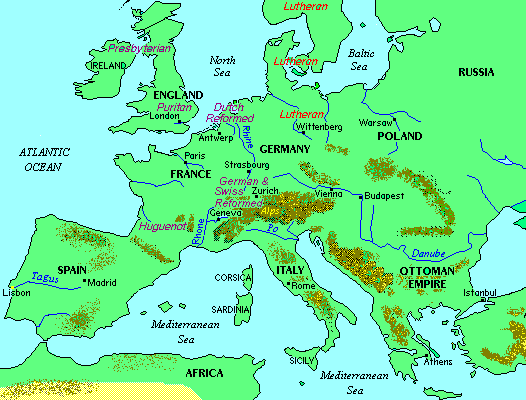
Who
were the English "Puritans"?
-
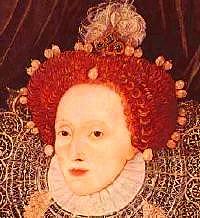 They were the English who had taken
refuge among the Calvinists in Switzerland and Germany during the reign
of Mary Tudor (Bloody Mary) and who returned to England when Elizabeth
came to the throne in 1558, ready to "purify" the English church along
Calvinist lines. Elizabeth needed their support in her struggles
to keep her throne against her many Catholic enemies. But she herself
was never as radical in her religion as these very pious and demanding
church reformers. They were the English who had taken
refuge among the Calvinists in Switzerland and Germany during the reign
of Mary Tudor (Bloody Mary) and who returned to England when Elizabeth
came to the throne in 1558, ready to "purify" the English church along
Calvinist lines. Elizabeth needed their support in her struggles
to keep her throne against her many Catholic enemies. But she herself
was never as radical in her religion as these very pious and demanding
church reformers. -
As with the other Calvinists, the "Puritans"
wanted the removal of all "fancy" or showy features of church life, everything
from the robes and adornements that the priests wore, to the paintings,
statues and stain glass windows of the church, to the use of Latin, incense,
chanting, and liturgical prayers performed by the priests. Instead
they proposed the simple use of English, prayers that came from the heart
(not a worshipbook), hymns sung by the congregation, and sermons not written
and read by professional sermonwriters in the bishop's employ but sermons
crafted by the local preacher out of his deep and prayerful study of scripture
(Puritans expected their pastors to be very knowledgeable about scripture,
not about church liturgy and doctrine like the Catholic priests).
-
The Puritans (as with all Calvinists)
wanted all the saints days or holidays (holy days) done away with and stress
placed on Sunday worship instead. Easter and Pentecost were the only
special Sundays observed (not even Christmas, whose timing they knew had
pagan, not Christian, origins).
-
The Puritans expected their pastors
to be married men with families, familiar with the everyday matters of
English life. They thought that their pastors ought to be university
graduates (especially from Cambridge, which was a key center of Puritanism)--well-read
and learned about things of the world (such as business and technology)
and able to relate the everyday lives of the parishioners to the will of
God revealed in the study of scripture and prayer.
-
Many of the Puritans were "presbyterian"
in their views on church organization: desiring all local churches
to be "connectional" with each other through the periodic meeting of higher
councils (presbyteries, synods and general assemblies) attended by representatives
of local churches and lower councils. These presbyterian Puritans
believed in "representative" democracy. Other Puritans were "congregational"
in their view that each local congregation should be completely able to
stand on its own in governing itself--through local meetings in which matters
touching on the life of the local community were decided by all the men
of the congregation representing the various families who made up the membership.
These congregationalist Puritans believed in "total" democracy.
-
Elizabeth tolerated these Puritans--as
long as their focus remained purely on matters of church worship and local
life. She was not keen on them however when they wanted to meddle
in national policies--and when they wanted to convert the church of England
from episcopalian (under the rule of bishops appointed by her) to presbyterian
or congregationalist.
-
Some of the Puritans were beginning
to give up hope of ever being able to "purify" the English church.
They became supporters of the idea of simply separating from the English
church and worshipping on their own under their own appointed pastors.
Elizabeth detested these "Separatists" and made life as miserable
for them as she could--arresting and even executing them when she caught
up with them. Many of these Separatists decided to leave England
and move to the Netherlands where they would be free to worship along Calvinist
lines.
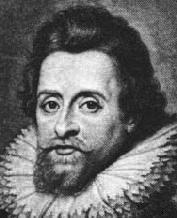 -
When Elizabeth died in 1603 and James
I came to rule England (1603-1625) there was much hope of the English
Puritans for a final victory of their Calvinist principles. Though
he was the son of the very Catholic Mary, Queen of Scots, as a young man
he had been surrounded and taught by Scottish Presbyterian teachers and
had already been ruling in Presbyterian Scotland as James VI since 1567.
-
As it turned out, he was Calvinist in
basic theology, but very Episcopalian (or Anglican) in his view on church
government. He also took the view that the King was the ultimate
"defender of the faith" in the land of his rule. By Divine Right
(supposedly God's will revealed in the circumstances of his birth as king)
it was the King who should appoint the officers of the church (its bishops)
and who should direct the theological life of the entire church under his
rule. Thus it was James who called for scholars to issue an "authorized"
English version of the bible--known still today more popularly as the "King
James Version" of the Bible. It was he who called for the redrafting
of the Book of Worship to be used in all English churches (which the Calvinist
Puritans and Separatists were by then strongly opposed to).
-
Needless to say, his strong views on
the "Divine Rights" of the English King made life miserable for the Calvinists
in England and Scotland.
How does this relate to the English
establishment of colonies in America (early 1600s)?
-
One of the things that helped ease tensions
with these Calvinists was James' granting of rights to Separatists to settle
in the English colonies in America--where they would be free to establish
communities that practiced their Calvinist faith and life. Thus in
1620 English Separatists received the right to be the first "pilgrims"
to America, leaving from Holland on the Mayflower to settle at Plymouth
in Massachussets.
-
Nonetheless, by the time of his death
in 1625, James had succeeded not only in alienating the English Puritans
but also the Scottish Presbyterians. Bit by bit he had taken away
the right of the Scottish church to elect its own members to the Scottish
General Assemblies and instead had given that right to bishops appoined
by him to rule over the Scottish church. When he died things were very
tense in England and Scotland.
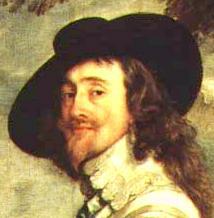 -
His son Charles I (ruled England
from 1625 to 1649) proved to be no better in the eyes of the English Puritans
and Scottish Presbyterians. In particular they hated the influence
that Bishop William Laud had over him. Laud was an Arminianist (believed
in salvation by "choice" rather than "election") and was such a high-church
episcopalian that he appeared to be almost a Roman Catholic at heart.
When Charles made Laud bishop of the very Puritan diocese of London, friction
began to mount.
-
In part Charles bought off some of the
Puritan opposition by offering them a royal charter to establish a colony
in America, the Massachussetts Bay Company, where they could live under
their own Calvinist (congregationalist variety) rule. In 1628 this
colony was established just to the north of the Plymouth Colony.
Soon large numbers of Puritans began to make their way to America to freely
practice their "pure" religion. In 1636 the Connecticut colony was
opened up to Puritan settlement and in 1638 the New Haven colony.
"New England" was being born.
-
To the south of New England in America
was "Virginia," founded in 1607 basically as a commercial--not a religious--colony
(though it too during its early years had a very Puritan governor).
The idea in Virginia was for settlers to send back the wealth of America
to England. No gold was found--but tobacco was. The Indians
showed the Virginia settlers how to raise this cash crop--and Virginia
finally had an economic purpose. Religion-wise, the workers were
mostly gentry and peasants with little or no interest in theology.
They were interested in the land and the money it could produce--not religion.
Anyway the King took back the charter of the Virginia Company, making it
into a royal colony -- with an episcopalian religious structure.
The Church of England ruled over by kings and bishops was satisfactory
to the Virginians.
What was happening in the meantime
on the European continent between the Catholics and Protestants (first
half of the 1600s)?
-
War--big time. Behind the religious
issues of course were always the political issues of whose will it was
that ruled in a particular land or kingdom. Thus Protestant Princes
and Kings gathered armies to fight against Catholic Princes and Kings (also
Bishops with armies).
-
The religious issue often got lost in
the larger political question: thus the very Catholic king of France,
Louis XIII and his very able advisor, Catholic Cardinal Richelieu, sided
with the Protestant princes and Kings of Germany and Scandinavia--only
because the French were afraid of how a victory of the armies of the Catholic
Spanish and Austrian Habsburgs might do serious harm to French power and
influence in Europe!
-
The saddest feature of this long drawn-out
struggle was what it did to the people of Germany. For 30 years (1618
to 1648) the battles between Spanish, French, Polish, Danish and Swedish
kings and local German princes raged back and forth across Germany.
The poor peasants caught in the middle lost their crops, their farms and
their lives through slaughter and starvation. As a result, the population
of Germany fell from 16 million to 6 million people over that time period.
-
Finally in 1648 a truce was declared
in the Treaty of Westphalia between all the parties fighting in
this war. Basically the Treaty promised that the Catholic, Lutheran
and Calvinist division of central Europe as of 1624 would be restored and
guaranteed by all the pinces and kings. Some areas would be Catholic;
some Lutheran and some Calvinist.
-
No one expected that the Treaty would
last. But everyone was so exhausted that they couldn't bring themselves
to go to war again. The Treaty of Westphalia in fact marked a rather
permanent division of Central Europe among these three religious groups.
Why does the English civil war now
take up at this point (1640)?
-
Meanwhile back
in England tensions were only growing worse between Charles and the Anglicans
on one side and the Puritans on the other. Tensions tended to play
themselves out most fiercely within the English Parliament (national legislature--like
our Congress) especially in the House of Commons where the prosperous Puritan
merchants, industrialists and agriculturalists were the largest group.
In a sense the religious struggle became one of a struggle between the
King and Parliament.
-
Actually the explosion
came first in Scotland when Charles (with Laud's encouragement) tried to
impose the Anglican worship form on the Scottish church. This was
the last straw for the Scottish who in 1637 began to resist and then rebel
against royal control of the Scottish (Presbyterian) church.
-
When in 1640 Charles
tried to raise an army to crush the rebellion, he had to turn to English
Parliament for the money necessary to equip and pay that army. That
proved to be a fatal mistake to a King who had tried to rule England without
Parliament for many years. Once Parliament was called into session,
the Puritan demands for reform began to gush forth. The situation
grew worse for Charles as the Scots now were invading England with their
Presbyterian armies.
-
Parliament now
began to act on its own. It had Laud arrested (and in 1645 executed).
It passed a law abolishing episcopal church government and replacing it
with a Presbyterian form for England. In 1643 it convened an Assemby
at Westminster of Puritan theologians to write a new religious confession
(the Westminster Confession of Faith) and a new worship formula
(the Directory) for all of England, based on Puritan or Calvinist
principles.
-
By early 1642
Charles was trying to fight back with armies of his own (drawn mostly from
the West and North of England) against the armies of Parliament (drawn
mostly from the South and East of England). The English Civil War
was thus underway.
 -
By 1645, the Parliamentary
and thus Puritan "New Model" army under the leadership of Oliver Cromwell
had completely destroyed Charles' royal army. Charles was arrested
and imprisoned.
-
Charles then tried
to split the Scottish Presbyterians from Cromwell's Puritans, because the
latter were becoming less interested in the rigors of ultra-Calvinism and
more interested in establishing an atmosphere of religious freedom for
spiritual pilgrims to follow out their consciences before God. Thus
Charles persuaded the Scottish Presbyterians to attack the"revisionist"
Cromwellians--a disaster for the Scots and the cause of death of Charles--who
was executed for his "treasonous" behavior in 1649.
-
This left England
under the leadership of Cromwell--for Charles' son, the future king Charles
II, had fled to France for protection. But Cromwell, the "Great Protector"
was not desirous of this job. He took it up nonetheless, and began
to put into place the full Puritan reform of England--and Ireland.
-
Needless to say,
his military style of governing began to rub English the wrong way (much
less the Irish who grew to hate him for the highhanded way he tried to
impose Puritanism on very Catholic Ireland).
-
And the petty
bickerings that began to break forth among the English Protestant leaders
did nothing to endear their rule to the English.
-
When in 1658,
upon Cromwell's death, his rule was taken up by his son, Richard, things
began to turn against the Puritan "Commonwealth." Richard was not
a capable leader. Dissatisfaction against the Commonwealth began
to spread rapidly.
-
In
1660 Parliament voted to restore the monarchy and invite Charles II to return from France and take the throne left vacant in England
since his father's execution.
-
But Charles returned
to an England just as suspicious of royal authority as it was tired of
Puritan strictness. Charles was relatively aware of the limits to
his position--and held a horrible memory of his father's undoing.
Thus Charles, though profoundly Catholic in spirit, kept his religious
views largely to himself and suffered himself to be surrounded by Protestant
advisors.
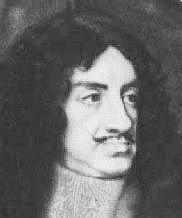  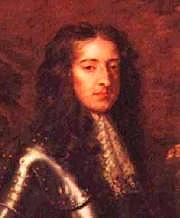 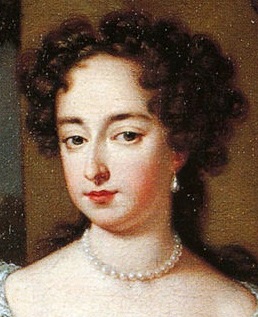
Charles II / James II / William III / Mary II
-
Nonetheless Charles
moved cautiously but surely against the Puritans, restoring Anglican order
in the church and forcing the English clergy to agree to Episcopalian forms
of church government. 1680 Puritan pastors gave up their positions
rather than to agree to these changes--thus becoming part of the Dissenters.
Worship of the Dissenters was made illegal and subject to heavy fines.
But Charles was not able to force the English into total compliance with
the restoration of episcopalianism or Anglicanism in the church.
-
.When
he died in 1685 his brother James II became king.
James was proud and vain and totally undiplomatic in his relations with
the people he ruled over. He ignored the laws of England when it
pleased him to do so. He surrounded himself with "Cavaliers" who
were openly Catholic in their loyalties--as part of his determination to
restore England to the Catholic church.
-
The effort backfired.
In 1688 Parliament rose up in rebellion and called on the Protestant Dutch
leader of the Netherlands, William of Orange, and his wife Mary (daughter
of James II!) to lead a Parliamentary army in the overthrow of James II.
James soon had to flee to France. William and Mary were asked by
Parliament to become together the king and queen of England (William
III and Mary II)
-
From 1689 on,
it was definitely Parliament, not the king, who ruled England. Anglicanism
remained the "established" form of church life in England. But Protestant
Dissenters were tolerated. Indeed, from this point on, religious
toleration now begins its path to becoming one of the highest principles
of English life and culture.
|









 Miles
H. Hodges
Miles
H. Hodges